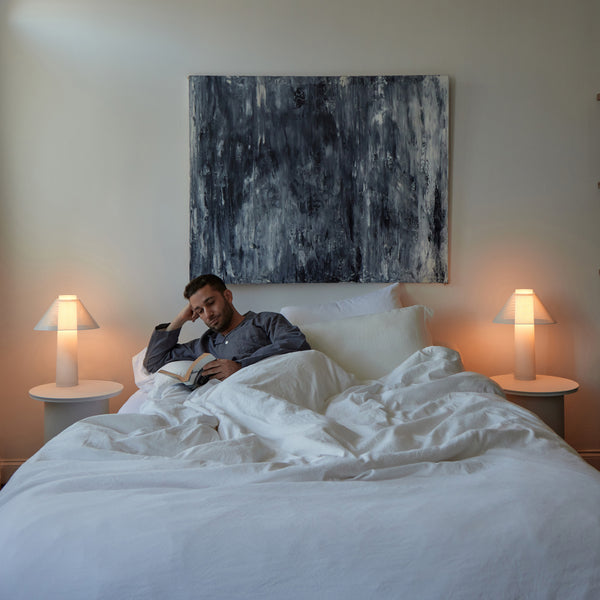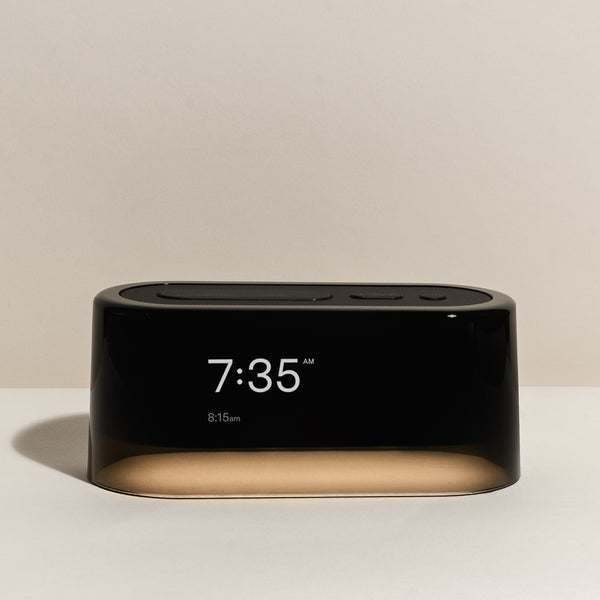Two of the most important factors for our sleep are light and temperature. Obviously we can’t always create our ideal sleep environment, some factors are out of our control. But there are small things we can add or remove to make our bedrooms more conducive to feeling relaxed and ready for bed. When it comes to lighting, we hear a lot about avoiding blue light before bed but what color light helps you sleep? Here are some of the best colors to keep in mind for bedtime.
Research shows that even 40 minutes of blue light before bed can lead to increased heart rate and alertness. Another color studies show could be equally as disruptive to our melatonin levels, is green light. This is another reason to try red or amber lights because they mask blue and green light.
Relaxing lighting can improve your natural melatonin production, muscle relaxation, help you feel more alert when you wake up, and much more. It’s also important to note that red or amber colored lights that haven't been specifically designed to help with sleep still emit blue and green light even though you can't see it with the naked eye. Using these kinds of lights can still disrupt your sleep as your eyes will absorb the blue and green light emitted from them. It’s important that you buy the best color light for sleep from a trusted retailer.
Best Light Colors For Sleep
For some, it’s the absence of light that makes the difference at bedtime but if you have a partner that prefers some light, or if your current routine isn’t working, lighting could be a solution. Light is very tied to our circadian rhythm, the natural process we all experience every 24 hours. Our circadian rhythm signals to our brain when to produce certain hormones that tell us it's time to wake up and go to sleep. Centuries ago, our circadian rhythm followed the sun, but because so many of us spend our days staring at a computer our body isn’t getting the proper signal. Here’s how you can use light to get back on track.Red Light
Red is the best light color for sleep, probably because it reminds us of the natural sunset. A small study in 2012 examined the effects of red light therapy on elite female athletes. Researchers found that 30 minutes of red light exposure significantly improved sleep quality and melatonin levels after 14 days compared to those who were not exposed to any light. Participants who received red light exposure also saw an increase in their endurance performance. It’s important to note that red-colored lighting will not get you the kind of results you’re after for sleep. The most effective red lights are from high-power LED that emits red light wavelengths like the Loftie Lamp.Yellow Light
Amber or yellow light has a quality similar to candle light which can be very calming. According to the CDC, yellow light has little effect on our circadian clock so while it may not have the proven effects of red light, it is a better choice than blue or bright light if you’re wondering what color light makes you sleepy. Amber or yellow light is a great alternative for bedroom lighting if red light is too distracting or you want to try something other than standard LED.Worst Colors to Light up a Room for Sleep
Blue light as we know is nearly impossible to escape. It’s in our phones, laptops, tv screens, and most fluorescent lighting. Constant exposure has a significant impact on our sleep because it’s highly stimulating. Limiting or eliminating it entirely before bed is the best way to improve your sleep.Research shows that even 40 minutes of blue light before bed can lead to increased heart rate and alertness. Another color studies show could be equally as disruptive to our melatonin levels, is green light. This is another reason to try red or amber lights because they mask blue and green light.
Ways to Manage Blue Light
The easiest way to eliminate your exposure to blue light is by removing screens from the bedroom and not looking at your devices 1-2 hours before bed. If this is just not possible, you can try blue light-blocking sticker dots or switch your screen setting to night or dark mode which will change your background from light to dark. Another option we obviously love is the Loftie Lamp because it gradually brightens with soft natural light in the morning then dims during the evening. This signals to your brain and body that it’s time to go to bed.Benefits of Using Calming Colors for Sleep
If you’ve struggled with sleep then you understand just how detrimental it can be to your mood, relationships, and overall well being. Adequate sleep is so important and there are many factors that are out of our control which is why adjusting your lighting and temperature can be so helpful.Relaxing lighting can improve your natural melatonin production, muscle relaxation, help you feel more alert when you wake up, and much more. It’s also important to note that red or amber colored lights that haven't been specifically designed to help with sleep still emit blue and green light even though you can't see it with the naked eye. Using these kinds of lights can still disrupt your sleep as your eyes will absorb the blue and green light emitted from them. It’s important that you buy the best color light for sleep from a trusted retailer.
Other Factors to Consider for Better Sleep
In addition to choosing the best lights for sleeping, a nighttime routine can also improve your sleep. We suggest you pick a sleep and wake up time and stick to it (even on weekends). Our internal clock needs time to develop a new routine so it’s best to incorporate stretching, non-caffeinated tea, or even a puzzle. Another way to make the transition easier is with the Loftie Clock, a two-phase alarm that mimics your body’s natural waking process. It wakes you up gradually, rather than jerking your brain out of sleep.
Loftie Lamp
A light that brings you healthier sleep and happier mornings.
Translation missing: en.upsell_product.general.sale_price$249.99




















